The kidney bean comes by its name honestly. It’s shaped like a kidney. That aside, kidney beans do come in many colors and sizes. There’s the red kidney bean, the red speckled kidney bean, the light speckled kidney bean, and even the white kidney bean, also known as the cannellini. Large red kidney beans are popular in India while the smaller ones are more common fixtures in Creole cooking, especially in red beans and rice. No matter their color or proportions, however, they all pack incredible health benefits.

Why Kidney Beans are Good for Older Adults
1. Kidney beans are high in molybdenum.
What’s molybdenum, you ask? It’s an essential trace mineral that enables our bodies to metabolize fats and carbohydrates, and break down certain amino acids. Kidney beans, like many other pulses, are bursting with molybdenum. One cup of cooked kidney beans has nearly 300% of what we need each day, helping our bodies perform optimally.
2. Kidney beans are a low-fat protein source.
Combine with a grain, such as bread or rice, to give your body a complete protein. Just 1 cup of cooked kidney beans provides nearly 1/3 of the protein we need each day. Meals of dark red beans and rice may also provide non-pharmaceutical management of type 2 diabetes, thanks to their glucose-lowering effects for up to 3 hours after eating them.
3. Kidney beans are heart healthy.
Red kidney beans have a surprising amount of omega-3 fatty acids. One cup of cooked kidney beans provides 56 milligrams. Research shows that plant-based omega-3 fatty acids called alpha-linoleic acid (ALA) can be just as beneficial in preventing cardiovascular disease as those obtained from animal sources, such as fish and seafood.
4. Kidney beans boost brain health.
Kidney beans have several brain-boosting nutrients, including omega-3 fatty acids and thiamin. One cup of cooked beans contains nearly one-fifth of the thiamin, also known as vitamin B1, that we need each day.
5. Kidney beans are a source of polyphenols.
One study found that speckled and red varieties of beans, like kidney beans, were higher in certain polyphenols than other legumes. As a result, they showed more antioxidant and anti-radical activity than light-colored beans.
Who Doesn’t Love a Big Bowl of Chilli on a Brisk Day?
Dark red kidney beans are usually the stars of this substantial dish, whether you enjoy a vegetarian version or prefer yours padded with toothsome ground beef.
Kidney beans also feature prominently in curries and soups. They’re an important part of any bowl of minestrone where they’re paired with lots of vegetables. And they partner with pasta in another popular Italian soup, pasta e fagioli.
Kidney beans are nothing if not versatile, thanks to their different sizes and colors but no matter how you choose to enjoy them, they must be cooked properly and thoroughly. Unlike other common beans, raw kidney beans contain high amounts of the toxin photoemagglutinin, and must be pre-soaked then boiled for 30 minutes to be safe to eat. However, canned kidney beans can be consumed as is, and make excellent and easy additions to salads, soups, stews and dips.
4 Healthy Recipes With Kidney Beans
1. Red Beans and Rice from the Food Network

2. Red Kidney Bean Curry (Rajmah) from Smitten Kitchen

3. Kidney Bean Side Salad from Chef Steps

4. Pasta e Fagioli from Serious Eats





